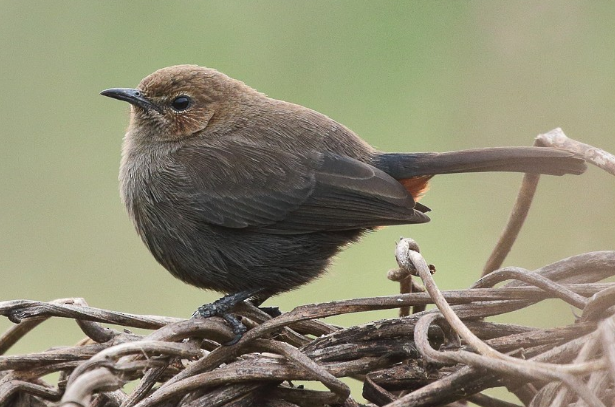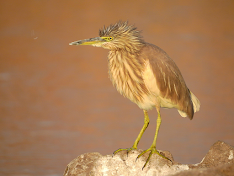Have spent the week in Udaipur at Basic Health Services, going to their far-flung clinics, observing doctor-patient interactions, laboratory processes, tests done etc. I remember going off alone before on work-related trips but it's been long enough that it feels like a different lifetime (I think the last one was for a conference in 2008!)
This time, the man and the kids have been managing by themselves and I have had the opportunity to focus on work, and during my time away from the clinics, bird-watch. I am happy that I have been able to go on exploratory walks, learning about the city and its birds nearly every day. I am also glad to have been able to observe some critical growth as a birdwatcher in myself.
My attitude to birding has gone through phases, from frustrated novice to insecure and inexperienced to impatient and full of FOMO to my present state of acceptance. The greatest influence here has been the book "The Living Air" by Aasheesh Pittie. I have not read this book yet, but I read the foreword by Mark Cocker. There, Cocker describes Aasheesh Pittie's capacity to spend many hours in fascinated observation even of the most common birds (in this case, it was the dabchick, a small and rather drab, dull, brown bird in most local waterbodies that ducks in and out of water). For some reason, this felt like permission that I could spend just as much time observing the bulbuls, tailorbirds, sunbirds and mynahs of common city life as I could spend hunting for the yellow rumped honeyguide or the green magpie in the Himalayas in Sikkim. Once I embraced this notion, all birdwatching has become precious... the time spent gazing at a crow tearing apart some food is not wasted time, but a privileged glimpse into its life. Why spend time anxious and impatient to go to exotic places to hunt out exotic species or feel like you are falling behind in your growth, when you can make your learning about what you already know deeper and deeper? Why put a price on the value of a birdwatching experience?
With this rather mellow attitude, I have found intense joy in birding in Udaipur. I should point out that Udaipur in July, after the first wave of monsoon rains, is paradise. Its lush green Aravalli hills roll into the distance with all the professed beauty of the English or Scottish countryside, its lakes are brimming over with clean rainwater and small rivulets and streams run happily alongside country roads. It is still small by Indian city standards and birds that are now non-existent in larger Indian cities, such as sparrows and swallows, throng here in large numbers. There are farms and fields in the center of the city! There are old style constructions which allow small birds to nest within nooks and crannies. There is a prevalent culture of bird-feeding with clumps of nuts and grains or shallow pots of water left outside nearly every house.
I won't go into details about the birds I saw during this trip, but will direct you to the eBird checklists I created: here, here, here and here)
There have been two other major ways I have improved as a birdwatcher:
a) Looking at an unknown bird and considering the possibility that it is a female: We all gaze at the colors and antics of the male birds, which tend to be attractive and eye-catching. The females, of course, wear drabber colors and do not need to go through masculine antics. I saw a chocolate brown bird with bright eyes foraging on the soil of the patch of land behind the BHS clinic at Kojawada and almost fell off the terrace in my attempts to keep it within view. The feature that made me think of female birds was the fluffy patch of reddishness near the vent (which is a fancy way of saying butt), and which is a distinguishing feature of the male Indian robin.
 |
| Female Indian robin. Image from https://ebird.org/species/indrob1/IN-RJ-UD, Rahul Singh |
The bird above is smaller and plumper than the ones I saw, but you get the idea. With bated breath and slightly trembly fingers, I looked up pictures of the female robin and was thrilled to find it was the same. I have since seen the female multiple times and always feel a sense of kinship.
If you would have watched me, some years ago, go through hours and hours of all sorts of mental acrobats before figuring out a particular bird was a female cuckoo, you would get why the ability to reasonably quickly identify a female robin thrills me no end.
b) Breeding plumages of birds: Near where I stay is the Ayad river. It's a bit of work to birdwatch here because of the insane number of flies that buzz around you all the time, trying to sit on your eye and mouth and disgusting things like that. It's because of all the trash that is thrown on the banks, and the smell doesn't help. But in my new, all-accepting avatar (may it thrive and grow!), I (wo)manfully ignored all this and spent a good long time on either side of the bridge staring at the water. I came across one fellow with the most splendid beak- pale blue near the nose, then a splash of bright yellow and a black tip. The beak threw me off. If I hadn't observed the beak, I would have said, "Ah, Mr. Pond Heron, nice to see you here" but the beak suddenly made him look a far more sophisticated specimen than the homegrown little fellow who fishes in my backyard open drain in Bangalore. I was like, "Could you be a relative? Are you a subspecies found here and not in Bangalore?" But turns out, this is what pond herons in the breeding season look like- their beaks become brighter and have these starkly beautiful colors on them!

The pond heron doth clean up but good for his lady. Pics from Wiki Commons
I find bird watching astonishingly meditative. One has to be fully in the present. Any distractions, and you could lose sight of the bird forever. It is deeply restorative for the spirit- there is something very healing in being able to observe a bird crooning to itself or its young ones, or engaging in aerial displays just for the sheer fun of it (last evening I saw a flock of swallows zooming around at top speed swerving and veering, much like young boys on motorbikes doing wheelies), or raucously calling to its friends (yes, parakeets and babblers, I am looking at you, you noisy creatures) or being deeply paranoid about its young (red wattled lapwings, if you don't want people to find your eggs, don't lay them next to the road and then spend the next few hours shrieking at everyone). There is a sense of being part of something larger and realizing that deep, true and real worries and feelings are almost exactly the same regardless of whether you are a human or a bird.
